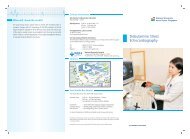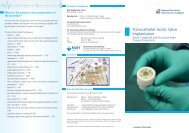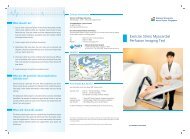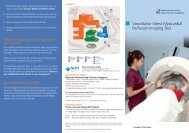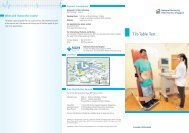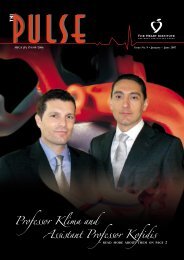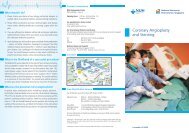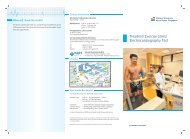Permanent Cardiac Pacemaker Insertion - nuhcs
Permanent Cardiac Pacemaker Insertion - nuhcs
Permanent Cardiac Pacemaker Insertion - nuhcs
Create successful ePaper yourself
Turn your PDF publications into a flip-book with our unique Google optimized e-Paper software.
VeinLeadsIncisionCollarboneGeneratorDuring endocardial implantation, the generator is placed below the collarbone andthe leads are placed inside the heart.Why is a <strong>Permanent</strong> <strong>Cardiac</strong> <strong>Pacemaker</strong> needed?Excessively slow heart rhythms can severely affect the heart’s ability to pumpblood throughout the body. This may cause symptoms such as fatigue,dizziness, shortness of breath, fainting and in extreme circumstances, death.In such cases, your doctor may recommend a permanent pacemaker to beimplanted. In some patients with heart failure, a special pacemaker may beimplanted to improve the heart function (<strong>Cardiac</strong> Resynchronisation Therapy).A pacemaker comprises 2 parts: the pacemaker box (also called the pulsegenerator) which is a sophisticated piece of equipment with microcomputersand a battery, and wire (also called leads) which are inserted in the heart.The pacemaker box is about the size of a small lighter and is made of inertmetal alloy. The battery usually lasts 7 to 10 years, after which the entirepacemaker box is changed. The wires are inserted into the heart via theveins from one of the arms. Modern pacemakers systems are extremelyreliable and after implantation, are unobtrusive and do not affect youractivities of daily living. Most patients notice an immediate improvementin their condition and symptoms after insertion of a pacemaker.An X-ray showing the generator and the leads are placed inside the heart.will also be checked and programmed by a technologist. Most patientscan be discharged one or two days after the implantation.What can I expect?Picture of a modernpacemaker generator. Afifty cents coin is includedfor size comparison.your hand to facilitate injection of medication. You will be asked to fast onthe night before the procedure. Just before the implantation, you will begiven an injection of an antibiotic.The implantation is performed in the Invasive <strong>Cardiac</strong> Laboratory. Afterinjection of local anaesthetic, a small incision (cut) is made in the upper leftchest (if you are right-handed) and a small “pocket” is created under theskin to accommodate the pacemaker box. An insulated lead is then insertedthrough a vein in the upper chest and, guided by X-ray, is threaded untilits tip lies snugly within the heart. The other end of the lead is then connectedto the pacemaker. The incision wound is closed with stitches, cleaned andbandaged.On returning home, you can resume most daily activities within a few days(please see instructions below). Take care to keep the wound dry. Thewaterproof dressing should be changed daily for a week to 10 days afterwhich it should have healed. The stitches need not be removed as theyare absorbable. Your doctor will arrange a schedule of periodic checks,and will electronically program the pacemaker’s behavior to suit yourrequirements.What should i do after my pacemakerimplantation?1. You should watch for fever, excessive pain, redness or swelling overthe wound. Inform your doctor immediately if you have these symptoms.You will need to stay in hospital for 3 to 4 days for the pacemaker implantation.The implant procedure usually lasts about one hour, and is performed underlocal anaesthesia with sedation. Before the procedure, some routine bloodtests and electrocardiograms may be performed, and you will be requiredto sign a consent form. A small needle is inserted in one of the veins onUpon returning to the ward, you will be given regular antibiotic injectionsto reduce the risk of infection. Please inform the attending nurse if youexperience pain at the implant site; painkillers can be prescribed. Thefollowing day, you will be sent for a chest X-ray to check the position of thepacemaker and wire, and to look for potential complications. The pacemaker2. On the side of the pacemaker, avoid excessive movement of the arm,lifting the arm above your head and lifting more than 5kg load for 2weeks after implantation.3. Complete the course of antibiotic medication prescribed on discharge.



